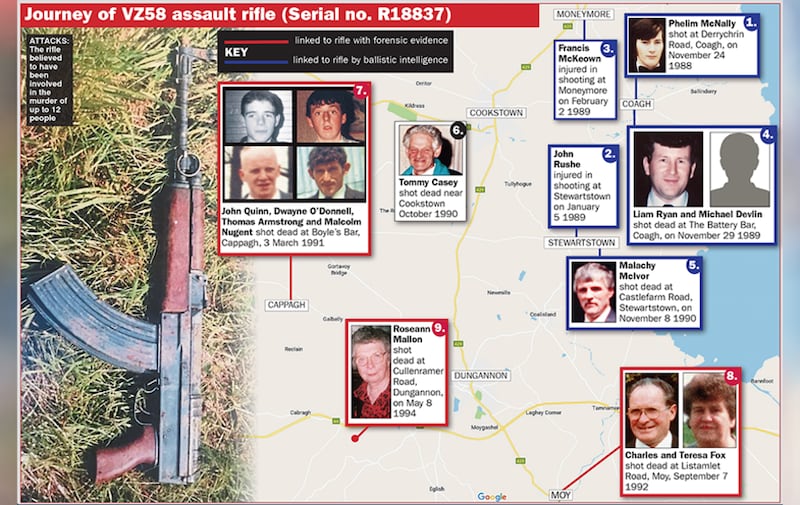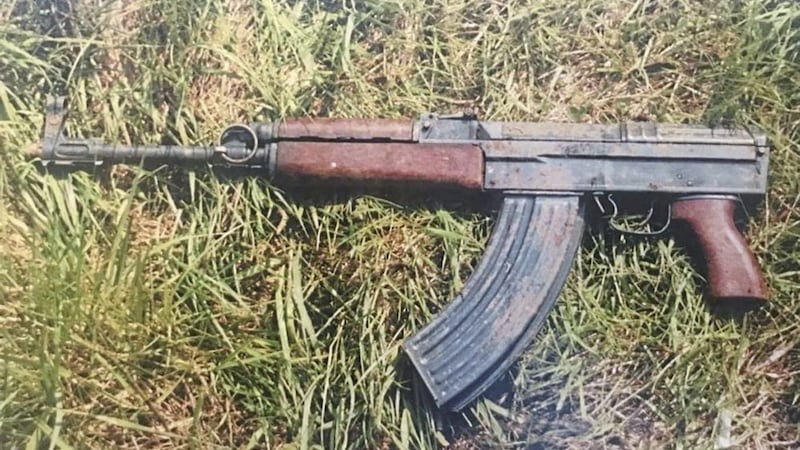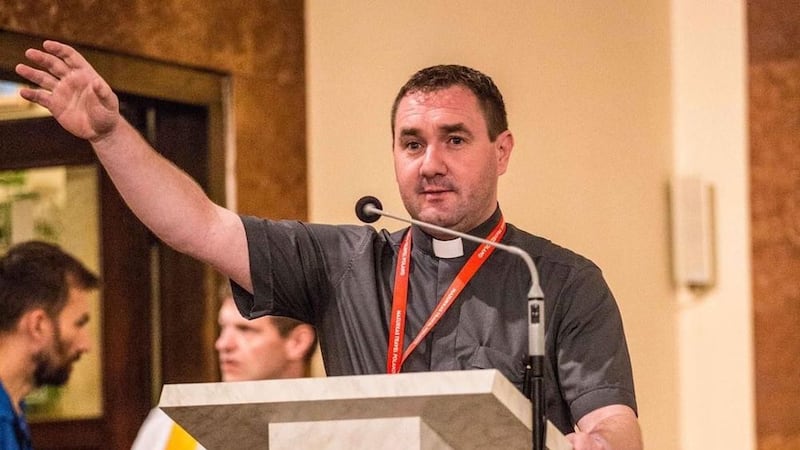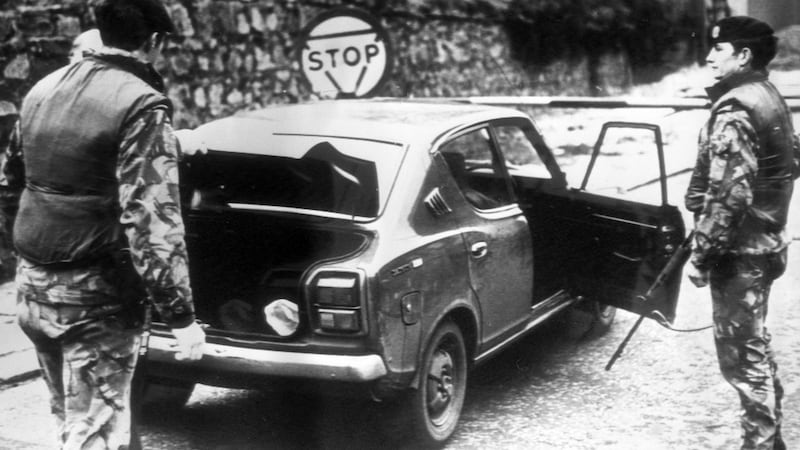A powerful gun smuggled into the north by loyalists during the Troubles is believed to have been used in the murders of up to 12 people.
The VZ58 assault rifle, with the serial number R18837, was among a batch secretly obtained in the late 1980s amid claims that British intelligence agents were involved in the plot or aware of the shipment.
For the first time we can reveal its blood-soaked journey over six years between 1988 and 1994.
While several of the attacks attributed to the weapon were initially blamed on the Protestant Action Force, a cover name for the UVF, the majority have been directly linked to the main organisation.
It is also suspected by some that some members of the UDR based in Co Tyrone were involved in a sustained sectarian campaign carried out in the area at the time.
The Czech-made rifle was one of two similar weapons used to kill four men - three of them IRA members - at Boyle’s Bar in Cappagh, Co Tyrone, on March 3 1991.
Relatives of republicans Malcolm Nugent (20), Dwayne O’Donnell (17) and John Quinn (23) and civilian Thomas Armstrong (52) marked the 30th anniversary of their deaths last week.

A Historical Enquiries Team (HET) report into the killing of Mr O'Donnell, released by the PSNI last year, revealed that three part-time UDR members were among four suspects arrested in December 1991.
The arrests took place after a joint British army and RUC review undertaken "as a result of raised concerns of security service collusion in east Tyrone".
An examination of intelligence relating to several murders and attempted murders between 1988 and 1991 "highlighted concerns in relation to several members of 8 UDR" - which covered parts of Co Tyrone and had bases in Aughnacloy, Dungannon and Cookstown.
The HET report said intelligence was received naming three soldiers as being responsible for Mr O’Donnell’s murder.
In addition it claimed the UDR men “were also named as responsible for other murders”.
Minutes of a 2012 meeting between HET officials, Cappagh families and representatives of campaign group Relatives for Justice reveal that a named member of the UDR was identified as one of the suspects.
It was also recorded that the HET believed there were "probably four or five cases where UDR soldiers are linked to killings".
Members of the UDR have also been questioned in connection with the killing of Sinn Féin member Tommy Casey near Cookstown in October 1990.
A HET report into his death reveals that an intelligence report indicated the murder was carried out by south Tyrone UVF and that three men named as being involved were UDR soldiers.
The report confirms that the suspects were arrested along with two others, also in December 1991.
One of the additional two detained was also a UDR member.
It is believed the three UDR men arrested in connection with Mr Casey's murder and the Cappagh case are the same soldiers.
All those detained were later released without charge.
The loyalist gang operating in east Tyrone at the time used several weapons between 1988 to 1994, including R18837.
The rifle was part of a batch believed to have been shipped into the north in late 1987 amid claims that British intelligence agents were involved in the plot or aware of the shipment.
Weapons contained in the deadly cargo were later used to kill more than 70 people, many of them innocent Catholics.
The haul also included semi-automatic pistols, rocket launchers, grenades and ammunition.
R18837 has been linked - either through forensic evidence or ballistic intelligence - to as many as 12 murders and two attempted murders during eight different incidents across east Tyrone and south Derry.
The shocking history of the weapon has been pieced together through information gathered at an inquest into the UVF murder of pensioner Roseanne Mallon in May 1994 and reports published by the now-defunct HET.
Inquest documents confirm that ballistic intelligence has connected the gun to three killings and the two attempted murders.
The first victim, Phelim McNally, was shot dead at his brother’s home at Ballinderry in Co Tyrone in November 1988.
In January the following year it was used in the attempted murder of Johnny Rush in Stewartstown, Co Tyrone.
Another failed gun attack took place a month later when Francis McKeown escaped with his life in Moneymore, Co Derry.
Just over a year after Phelim McNally’s murder, R18837 was again used in an attack at the nearby Battery Bar, Moortown, in Co Tyrone, on November 29 1989.
IRA member Liam Ryan and local man Michael Devlin were killed when gunmen burst into the bar and opened fire.
A third man was injured but crawled to safety.
The same weapon was used to claim the life of Catholic man Malachy McIvor in Stewartstown in November 1990.
Several weeks earlier, in October 1990, father-of-11 Tommy Casey was shot dead near Cookstown.
While his name and that of Mr McIvor appear in some but not all inquest documents, they are both believed to have been victims of R18837.
Forensic evidence has also connected the gun to three separate attacks resulting in the deaths of seven people.
In March 1991, it was used in the Boyle’s Bar attack in Cappagh - the single biggest loss of life involving the weapon - which resulted in the murder of four men.
More than a year later, in September 1992, it featured in the brutal slaying of husband and wife Charles and Teresa Fox at their home near Moy, Co Tyrone.
The rifle’s final victim was 76-year-old Roseanne Mallon, who was shot dead as she sat in a relative’s house near Dungannon in May 1994.
Days later R18837 was found by police under a sheet of corrugated iron during a search of a derelict house not far from the Mallon murder scene.
The stock of the deadly weapon had been removed and the letter 'T' and 'UVF' had been punched or drilled onto the rear plate.
It subsequently emerged that the Weapons and Explosives Research Centre, which was run by RUC Special Branch, had claimed the gun used to kill Ms Mallon had no known history - a claim a coroner who presided at her inquest later said was “entirely wrong”.
A growing body of evidence appears to indicate that while there were UVF links to the R18837 series of murders, UDR members were centrally involved.
It is not yet known if R18837 came into their possession via the UVF or through Ulster Resistance.
A second gun used in the Cappagh attack was recovered in 1992.
The Historical Enquiries Team has confirmed that a VZ58 was used in three incidents before it was found in Co Tyrone.
The high-velocity weapon was discovered at Mossband Road, near Coagh, just weeks after the three UDR members were questioned about the Cappagh murders.
Two other weapons, a home-made submachine gun and a .38 special revolver, were also recovered in what some believe may have been a deliberate handover.
Solicitor Gavin Booth, of Phoenix Law, said: “This process has started to unravel with the recent release of the report on Cappagh showing the state-wide use of VZ58s."
Mark Thompson from Relatives for Justice said the importation of weapons by loyalists in the late 1980s with the alleged assistance of British intelligence "provided loyalism with an unprecedented capacity to wage sectarian attacks and carry out political assassinations".
“This happened at a time when the flow of intelligence documents, including personal details on republicans and nationalists, from the RUC and British army, including the UDR/RIR, to loyalists, increased significantly."








